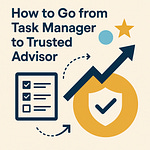Do any of these statements sound familiar to you?
“We expected your product to be able to do that with the click of a button. If you don’t have this feature we may need to look for another solution.”
“Your competitor is able to display our data as line charts and bar charts. Why can’t you do that too?”
These of course are fictitious examples but the pain that you may be experiencing may be similar. Your customers may have expectations that your solution is supposed to have certain features or work in a certain way and if it doesn’t, it’s broken. For the most part, I don’t blame the customer in these situations as most likely there were incorrect expectations that were set along the way. The problem is that much of this is out of your control for the following reasons:
The client felt they were promised certain features during the sales cycle that you had nothing to do with.
You have a limited ability to modify your product roadmap let alone the timeframe that your customer may be asking for in regards to these new features.
Lastly, your various client stakeholders have different agendas and objectives and both the people and the priorities change over time. This makes it challenging to balance what different people want and to ensure they are receiving value.
Regardless of the situation, you, as the customer representative, have to sort out this mess. One way to try and get things on a better track is to leverage the concept by Dan Sullivan and Benjamin Hardy called “The GAP and the GAIN”. Let’s dive into what this is all about.
Mind the GAP
Sullivan and Hardy used this concept of “the GAP and the GAIN” to explain why some people have such a hard time being happy. These people are always measuring themselves against an ideal that they have pictured in their minds. For example, they may expect to be making 7 figures by the time they are thirty and have a home and two kids. Not attaining that high salary or that house in the suburbs could send them spiraling out of control. Even when they may have actually accomplished their goals they may be unhappy with the size of their home or the job title they have. It never ends as they are in a constant “pursuit of happiness” (thanks Thomas Jefferson). This is called being in the GAP and it affects a large number of people.
If you feel that I may be describing some of your traits, you are not alone. I’m someone whose #1 strength as part of the CliftonStrengths is “achiever” and I’ve lived too much of my life in the GAP. My 12-year-old may have finished his homework and done his chores but I’ll scold him for leaving his dirty plate on the dinner table by mistake. I can be a real jerk at times as I’m focused too much on the GAP and not the GAIN.
A GAP mindset can really hold you back in life. In contrast to living in the GAP, living in the GAIN is measuring yourself against a starting point rather than against a future ideal. It’s about appreciating what you and others have accomplished rather than agonizing over what didn’t happen (or that it didn’t happen as you expected it to). How do you apply this concept to your customers?
Focus on the GAIN
The feature request that was mentioned at the beginning is a clear example of your client being in the GAP. How do you move the conversation from the GAP to the GAIN? Your goal should be to get your customer to be proud of what they have accomplished so far with your product rather than of what may be lacking. You can also point out the product improvements that have been made that have directly impacted them.
Here are my recommendations to move to GAIN thinking:
Make sure you know what your starting point is. Confirm the metrics that are important to your customers and the outcomes that they want to achieve. For example, if their goal is to unify all of their systems so they have a clearer understanding of their customer data, you will want to define that up front. This could be on the kick-off call or on a business review (QBR).
Track progress against the starting point & sell it. If you know the starting point, you can focus on how the client has progressed against this rather than focus on what they have yet to accomplish. Create a joint success plan or just define specific tasks that need to get done to demonstrate the progress being made. Focus on the GAIN (the progress) versus the GAP (what wasn’t done).
Leverage strategic meetings such as business reviews (QBRs) and other high profile meetings such as executive sponsor touchpoints to go over what has been accomplished. Point out the new features that have been rolled out -especially the ones that have directly impacted your client. Once the customer acknowlodges their progress, be sure to update all of the customer stakeholders. Sell those wins.Identify if the client is in the GAP early and address it. We all go into the GAP sometimes but there may be different ways to get out of it. That is why you need to identify any client issues early on in the relationship and attack them head-on. For example, if the client is expecting a feature, let them know if you will build the feature, if you won’t build it and if there are other options. You need to set the right expectations so that the client isn’t stuck in the GAP.
I’m not saying that by focusing on the GAP you can ignore all feature requests and other asks that your clients may have. However, when you are in a tough situation and your client may be fixated on certain issues, try and elevate the discussion beyond the problem at hand. As an example, I remember being in a tough renewal conversation where the client questioned the price we proposed. I reminded the client of all the progress we made due to their CSM’s assistance. The client acknowledged the high-quality service they were receiving and recognized that this was baked into the cost. We were able to shift the conversation from the GAP to the GAIN and secure the renewal.
GAIN some more happiness
Your challenge: Start to document all of the wins and accomplishments from just one of your customers. It could be new features or modules they have rolled out with your product. It could be configurations you helped them with or some wins from your support team. It could be them surpassing key metrics based on their defined outcomes. You could even just ask them: “what has your company found to be successful using our product?”. Get your customers into a GAIN mindset and I can guarantee that it will make you and your customers feel better.
PS: When you ask that “success” question, get ready to share the response with the rest of your organization as you will typically uncover a golden nugget. Get everyone into GAIN thinking.
PPS: This is more a reminder for me for a self-proclaimed GAPper. Focus more on what you have accomplished, what your family has accomplished, what your team has accomplished, what other functions have accomplished versus what they haven’t. Focus on the GAIN vs the GAP.
PPPS: Get in the GAIN and get happy!












